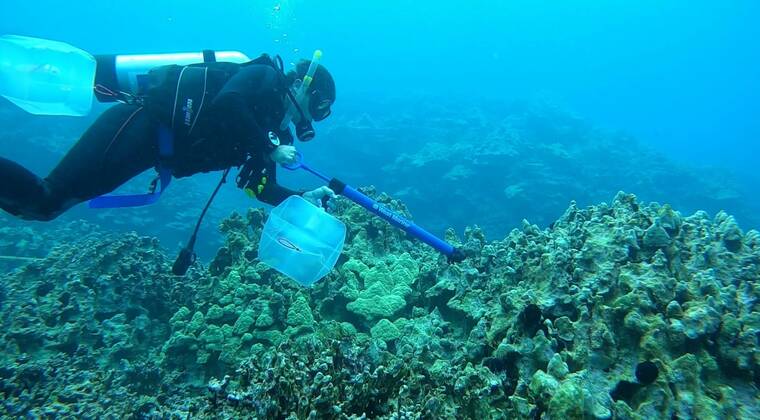The University of Hawaii at Hilo participated in one of the first all-encompassing research expeditions surveying coral reefs off the Big Island’s west coast.
Led by John Burns, an assistant professor of marine science, the expedition will help predict how environmental and human impacts influence reef ecosystems, while providing an opportunity for students to work alongside leading marine science researchers.
“It was a huge step for them professionally,” said Burns of the students. “It was their first chance to really work in an official capacity as opposed to a training capacity, which was great for confidence building, but also for giving them applied experience that’s going to help them be scientists.”
Students set sail April 5 from Pearl Harbor aboard the Oscar Elton Sette, provided by the National Oceanic and Atmospheric Administration. They assisted with data collection, dive teams, the filtering and sampling of seawater and held research leadership positions.
“Gaining hands-on experience through this cruise has definitely reinforced my pursuit of a professional research position,” said UH-Hilo graduate student Crispin Nakoa. “It was awesome to apply the skills I’ve gathered through my time in the UH-Hilo Marine Science Department and Tropical Conservation Biology and Environmental Science (TCBES) graduate program to work in collaboration with scientific professionals from other colleges and agencies.”
Burns is a UH-Hilo alumnus who founded the university’s Multiscale Environmental Graphical Analysis laboratory, or MEGA, which developed the tools used during the expedition such as their 3D modeling program to recreate habitat structures for categorizing and charting reef structures.
“We’re using advanced technologies to try and understand patterns, gradients and biodiversity across West Hawaii,” said Burns. “We have tools we’ve developed that are cutting edge and have never been applied to this area before.”
Assisting with the 3D mapping was Greg Asner and Kailey Pascoe from Arizona State University-Hawaii.
“Although it was a rigorous two weeks of diving, I’m very excited to see the data products and how we can use the scientific findings towards resource management,” said Pascoe. “This approach has the potential to transform management and conservation by determining critical features for reef resiliency that have yet to be incorporated into management.”
In addition to mapping, the expedition collected Environmental DNA, or eDNA, which can help identify hundreds of species present in reefs.
“Using eDNA is a new approach that’s similar to a crime scene investigation,” said Burns. “It’ll detect any organism in the general area from the DNA it releases and gives us a much more comprehensive picture of what type of organisms exist on the different habitat types.”
The information can also be used to identify areas needing protection and monitor long term changes taking place.
“Until you understand all the pieces of the puzzle, it’s difficult to manage it,” said Burns. “But when you understand the underpinnings of why what’s there is there, you can start to manage those specific factors and try to make improvements.”
Support was also provided by the Hawaii Division of Aquatic Resources for capturing visual fish surveying data.
“By all of us working together and combining forces, we were able to accomplish something none of these individual groups could have done alone,” said Burns. “This is the first project, probably globally, that’s done a large-scale habitat assessment like this that’s combined 3D modeling with the eDNA approach.”
The researchers and students compiled 113 3D models and fish surveys, 81 eDNA surveys, 507 individual eDNA samples and roughly 226 hours of underwater survey time.
Despite the overwhelming data, UH-Hilo students Lily Gavagan and Ashlynn Overly held their own among the group.
“The folks from NOAA were markedly surprised and impressed at just how competent and well trained the students were,” said Burns. “It speaks to how high the level of training is at UH-Hilo.”
The collected data will be analyzed in reports released over the next 1-3 years.
“We’ll know which reefs are in the best shape, which ones are in the worst shape, and where that tipping point is,” said Burns. “As well as when we need to be concerned.”
The results from the expedition will assist future researchers conducting their own work in the area.
“The beauty of our data products is that they age well,” said Burns. “The 3D models serve as a baseline, where we can go back and use them as a way to see how things change over time. Same with the eDNA data, you can always reanalyze the samples. And as tools get more advanced, we can reanalyze them again in the future. We’ll have results coming out of this for years to come.”
Email Grant Phillips at gphillips@hawaiitribune-herald.com

